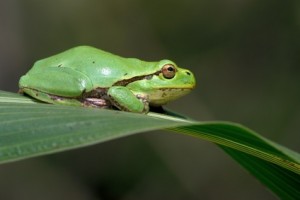

In the central Florida region, you can typically find three types of tree frogs – the Green Tree Frog, the Barking Tree Frog and the Cuban Tree Frog.
Green Tree Frog
Just like their name implies, the green tree frog is some shade of green. This can be a yellowish-green to a bright lime green to a dark green. They also have a pale yellow or white belly. These frogs can grow up to 2 inches long.
Due to the sticky toe pads, they can easily climb branches and twigs. They make wonderful pets and can be found in pet stores throughout Florida and south-eastern United States.
Barking Tree Frog
The barking tree frog is one of the largest tree frogs in Florida and can grow up to 2 ½ inches long. They are easily identified by its multiple spots, although the primary color could be brown, gray or green. This frog is named for the distinctive “barking” sound the males make.
They love being around water and if the area becomes too dry, these frogs will dig into the ground to find a source of water and moisture.
In 2011, the barking tree frog was officially declared the barking tree frog as Florida’s official amphibian.
Cuban Tree Frog
The Cuban tree frog is the species that’s been in the news the most lately. They are an invasive species – they are not native to Florida or to the United States. These frogs are difficult to identify as they can be a range of different colors and can even change colors. Some have spots and some do not. They are most easily identified by the following:
* A sound similar to a mraaaak.
* Bug eyes
* Very large toe pads
* Larger than most native tree frogs – from 2 ½ to 3 inches long.
* May have large warts
* They secrete a mucous-like substance through their skin that is extremely irritating to humans and can even trigger asthma attacks or allergies.
These frogs have very few natural predators and are voracious eaters. For that reason, they may be responsible for the decline of native tree frogs. If you find a Cuban tree frog, it is actually illegal to re-release them back into the environment. You are supposed to glove up to avoid the irritating mucous, capture the frog and apply a 20% benzocaine gel to put the frog to sleep. Once asleep, you are to put the frog in the freezer to kill it.
